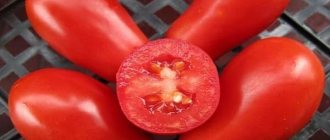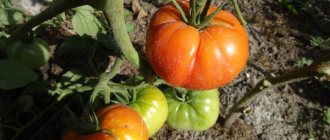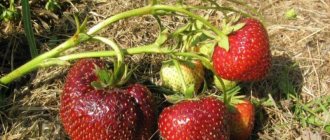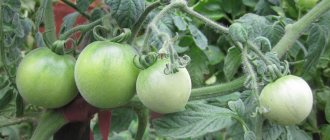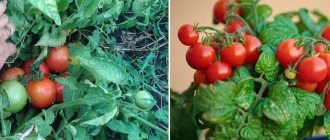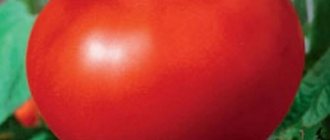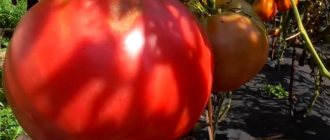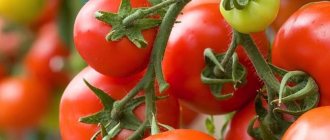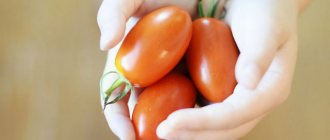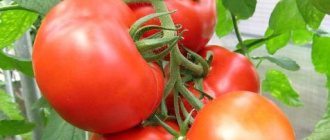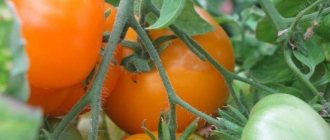Tomato is the most popular crop. As a result of the successful work of breeders, a wide variety of tomato varieties have been created, but many varieties and hybrids do not always meet our requirements. If previously the main direction in breeding for a long time was the creation of high-yielding varieties, now the requirements for varieties have changed.
When choosing tomato varieties, quality, taste and timing of product arrival come to the fore: varieties must be of different shapes, sizes and colors, smooth, shelf-stable, resistant to cracking, environmentally friendly, and have a biochemical composition favorable to the human body. What is interesting about tomatoes of Siberian selection and how to choose the right variety and hybrid? We also offer interesting new items for spring 2021.
Fleshy varieties of Siberian selection: Mystery of nature, Malachite box, Siberian trend
- What are Siberian tomatoes?
- How to choose tomatoes of Siberian selection
- Tomato varieties of Siberian selection for open ground and temporary film greenhouses
- Tomato varieties of Siberian selection for greenhouses
- New Siberian selection tomatoes for spring 2021
What are Siberian tomatoes?
In Siberian conditions, the growing season is short, late spring and early autumn frosts are possible. The varieties created for Siberia must be early ripening, cold-resistant, and disease-resistant. In case of acute heat deficiency, growing tomatoes in Siberian conditions is possible only through seedlings.
Taking these requirements into account, in Western Siberia, the Siberian Garden company has been conducting breeding work to create F1 tomato varieties and hybrids for more than 20 years. During this period, many varieties were created and entered into the State Register of Breeding Achievements, approved for use with different early ripening, plant type, shape, weight and color of fruits, and dry matter content. All of them are adapted to local Siberian growing conditions and meet the needs of the population in terms of quality and timing of product receipt.
New 2021: Siberian ground golden tomato
Variety of varieties and hybrids for the Siberian region
The main merit of breeders is the emergence of tomato varieties of different ripening periods. Thanks to the painstaking work of scientists, the first fruits from tomato bushes can be obtained without waiting for autumn. There are tomato varieties for the North-West that are not just early ripening, but ultra-early ripening, which begin to bear fruit at the end of June.
Reviews of the Riddle tomato inform about the unusually early ripening of fruits; it begins in just 85 days. This variety will appeal to lovers of dishes with tomatoes who do not want to wait patiently for the autumn tomato abundance. Productivity is low, but other positive qualities compensate for this minus:
- the miniature size of the plant, its “height” is only 40-50 cm, allows you to place from 6 to 8 bushes in a small bed the size of a square meter;
- the developed stem is stable without additional support, the type is determinate;
- the fruits ripen all of the same size, as chosen - round, red, weighing 80-90 grams (in a greenhouse up to 100 g).
Tomatoes in a bunch of 4-6 pieces. Another interesting feature, without which the description of the Riddle tomato would be incomplete, is the attractive absence of “extra” stepchildren. Stable resistance to most diseases has also been observed.
Close to the Riddle in terms of early ripening, these are the reviews of the Boni MM tomato from the experience of gardeners. It is harvested already 2.5 months after seed germination. In the southern regions they even refuse to prepare seedlings, the agricultural technology of this variety of nightshade is so simple.
Impressive bunches averaging 80 grams each on a miniature bush 50-55 cm tall are a common sight. The plant does not cause any trouble either in tying it up or in pinching it. Flat-round fruits of bright red color, good taste. Harvest – 1.5 -2 kg.
In the line of “Siberian Garden” varieties, the tomato is apparently invisibly distinguished by its ability to set 15 to 20 fruits of different sizes on the clusters. There really are a lot of tomatoes on one bush. If you leave 5-6 clusters for fruiting, the harvest will be approximately 4 kg. Tomatoes are round in shape, and their weight varies from 50 to 300 grams.
The ripening process is uneven and lasts about a month. Given that this species is classified as an early species, it should be expected that tomatoes will be collected from the bush until the very last moment of the plant’s life. The description of the Visibly Invisible tomato was first recorded in 2001 by Siberian scientists. According to the type of cultivation, it is classified as medium-sized determinate.
The description of the variety and characteristics of the Yamal tomato are very familiar to all fans of the early compact representatives of nightshade crops:
- a determinate, truly tiny bush reaches only 40 cm, and this is in a greenhouse (on the ground it is 25-35 cm);
- on a site of 1 sq. m are perfectly adjacent to 6-8 plants of the species;
- From one bush you get about 1.5 kg of tomatoes;
- Harvest time: 85 days from sowing.
For such miniature tomatoes, the yield indicators are record high. In the phase of biological maturity, the fruits are beautiful red in color with a strong skin. The taste is excellent, sweet and sour. High dry matter content (4-5%).
In the top decorative tomatoes, reviews of the Yamal tomato elevate it to the leaders. This plant has an irresistible visual appeal during the fruiting period, when it is hung with tomatoes of different shades and sizes. Will decorate any loggia. It will grow without problems on the windowsill in the kitchen. Very convenient - picked from the bush and immediately into the salad.
At the beginning of the second decade of the 21st century, reviews appeared about the Lazy Siberian Garden tomato, an early ripening hybrid of the first generation. The product of selection by Siberian creators is characterized by increased cold resistance, which is what they wanted from it. Determinate, standard type. Usually the height of the bush does not exceed 60 cm. Compact, well-leafed, productive, early ripening type of tomato.
A tomato with a potato leaf, this description of the Yablonka tomato in Russia is inherited along with the seeds by many generations of gardeners in our country. The determinate standard plant grows tall, about 100 cm. Thanks to many years of work on improving the variety and without unnecessary work on the formation of the bush, it produces a consistently high yield of small spherical fruits of about 100 grams.
The small oblong-round tomato Shaggy Bumblebee resembles a peach with its velvety fluffy skin. On one bush 3-5 kg of pubescent pink-red tomatoes ripen. The time from immersion of seeds in the soil to the first ripe tomatoes is about 120 days. The bush is standard, with a final growth point.
The early ripening hybrid tomato Server F1 is classified as determinant. The relatively small height (60 cm) and compactness of the plant determine the love of farmers with a small plot of land. The region of residence will prefer the south. In the conditions of the Siberian summer, good results from the variety should be expected only in the warm climate of film shelters. Spherical bright red fruits from 60 to 150 grams (this depends on the sufficiency of heat and light).
Tomato Server F1
In 2008, in the list of mid-early fruiting tomatoes, a description of the Nature's Mystery tomato, bred in the Siberian region, appeared. This is a representative of indeterminate large-fruited varieties for any type of cultivation. The fantastic coloring of the flat-rounded fruits is of interest. At biological maturity, it is unevenly orange and red on the outside and soft pink on the inside.
Perhaps the name of the variety was given precisely because of this feature. The fruits can reach 700-800 grams of weight. Excessive watering causes cracking. The taste is sweet. The peel is thin, not too strong. Harvest from 8 kg. Long-distance transportation requires increased care when handling tomatoes. Immunity to tobacco mosaic, late blight and blossom end rot has not been confirmed.
Amateur gardeners are happy to leave reviews about the Siberian Garden Red Truffle tomato on forum sites and exhibitions of agricultural achievements.
A beautiful, non-standard shape reminiscent of a red pear and an excellent piquant taste elevate the variety to a prize-winning place in the ranking of mid-season tomatoes.
The following characteristics should also be added to the description:
- standard formation - two stems;
- fruits in simple clusters of 4-8 pieces;
- average fruit weight is about 150 g;
- from 6 to 8 kg of yield per unit.
To all that has been said, add excellent immunity to late blight and other problems of nightshades.
Similar to a pear and tomato 100 poods, but only quite large in size. The surface of its fruits is strongly ribbed and the color is pink-red. Fruit weight is from 100 to 350 grams. Ripening period is early. The plant is tall, without a final growth point, reaches 1.8 - 2 m. Fruiting is cluster, 3-5 pieces. Productivity is high. Universal use in cooking.
The Tarasenko tomato is in no way inferior to the Red Truffle; its yield in favorable years reaches fabulous numbers - 20-25 kg. The hybrid for any soil is tall and liana-like. The length of the main stem exceeds 2 meters. The fruits are 200-300 grams, smooth, thick-skinned, red with an orange tint, fleshy, collected in fan-shaped clusters.
Tomato Tarasenko
Dessert from the garden
The chocolate-covered Zephyr tomato got its unusual name for its amazing brown-red color. Greenish longitudinal streaks on the peel give the zest to the color. The sweetness of its round fruits is so great that they can successfully replace dessert. It is thanks to this persistent sweet taste that the variety is extremely popular, despite its relative “youth”.
With its oblong cylindrical fruits, the Zabava tomato will appeal to all land plot owners without exception. Not only is the aesthetic appeal of tall bushes, hung with bunches of unusually long tomatoes, great. Productivity is also worthy of praise. From one bush you get 8-10 kg of fruits suitable for canning.
Numerous positive reviews about the Canary tomato can be found on Internet sites where residents of the Siberian region and Altai Territory appear. It is in their changeable climate that the large-fruited mid-season variety produces a record harvest. There is no secret here. The variety is “local”, bred in Siberia and for Siberia. Even in short daylight conditions it produces over 10 kg of large scarlet tomatoes weighing 180-200 grams. The plant is indeterminate, tall. Mid-early fruiting period.
How to choose tomatoes of Siberian selection
Currently, the range of tomato varieties and hybrids from the Siberian Garden AF is rich and varied, and it is difficult for an inexperienced buyer to navigate the stream of names and characteristics. It is necessary to follow the basic criteria: 1. Origin of the variety - it must be adapted to the soil and climatic conditions of your zone. 2. Growing season - in the assortment of each gardener there should be at least 4-6 varieties with different ripening periods - from ultra-early ripening to late ripening, in order to lengthen the period of fresh fruit consumption. 3. Bush type - for open ground, choose varieties with a determinate bush type. They are quicker to ripen, most of them are low-growing, and do not require pinching or gartering. Indeterminate (unlimited growth) varieties are grown in film greenhouses or in open ground, but they need staking and bush shaping. 4. Characteristics of the variety - weight of the fruit, shape, color, directions of use - for each consumer according to his needs.
Low-growing tomatoes for open ground
Varieties bred for the Urals and Siberia are able to withstand unfavorable conditions such as low temperatures, heavy rains and short daylight hours. Varieties for open ground are characterized by a short growing season, compact bush size and unpretentiousness.
Buffalo Heart
Bushes of the determinate type stop growing at a level of a meter in height.
Each plant produces 7-9 kg of fruits with excellent taste. The average weight of a tomato is 500 g. The shape of the tomatoes is heart-shaped, the pulp is juicy with a small number of seeds.
Fruiting is long-lasting, the first harvest will ripen in 100 days.
One of the advantages of the variety is its high immunity to most diseases.
Bullfinch
An ultra-early tomato, resistant to sudden temperature fluctuations and little sunlight. The bushes do not require garter; the plant height rarely exceeds 50 cm.
Productivity is 6 kg/m2. Round, smooth fruits weighing up to 150 g are painted in a rich red color. The variety is resistant to late blight and drought.
Barnaul Cannery
The tomato is resistant to low temperatures and lack of sunlight. Orange-red, round tomatoes with a dense skin are intended for canning in their entirety.
Friendly ripening occurs after 100 days. The average specimen weighs about 70 g. The bushes are low, up to half a meter high.
Siberian
The tasty and productive variety is unpretentious. Does not require additional support, stops growing after the formation of 5 fruit clusters. The purpose of the fruit is universal.
The Siberian tomato ripens in 3.5 months. Tomatoes weighing up to 100 g have a smooth, round shape and a rich red color.
Buyan Yellow
A tomato that is resistant to cool climates and has high yields. The rich yellow fruits ripen in 3-3.5 months. The compact bush does not require pinching or support.
Thanks to their dessert taste and thick skin, Buyan tomatoes are suitable for salads and whole canning. The weight of an average specimen is 90-120 g.
Bouquet of Siberia
Mid-season variety with compact bush size. On each plant, about 30 tomatoes of the same shape and size ripen at the same time. The weight of each fruit does not exceed 60 g. The surface is smooth, glossy, and red. The universal purpose of tomatoes. Excellent transportability and disease resistance.
Watercolor
Fruit set begins after the fourth leaf. Each brush produces six identical-sized tomatoes. Their shape is oval and their color is bright red. The photographs confirm the accuracy of the description of the variety. A yellowish area stands out near the petiole.
Like any other vegetable crop, Watercolor has its own advantages and disadvantages.
The advantages include:
- unpretentiousness;
- high productivity, independent of weather conditions;
- resistance to a number of diseases;
- high sugar content of the pulp;
- rapid ripening of tomatoes.
The disadvantages of this variety include that the skin of the fruit is too hard, so they are good canned and retain their integrity during heat treatment.
Tomato varieties of Siberian selection for open ground and temporary film greenhouses
We bring to the attention of readers a brief description of the best F1 varieties and hybrids of the Siberian Garden AF, which have become widespread in many regions of Russia. Ultra early: Turbojet, Ultra early. Early ripening, productive: Siberian ground raspberry, King of the early ones, Little Red Riding Hood, Lazy Girl, O-la-la, Pani Yana, Siberian trend, Minion of fate, Barmaley, Gina.
Tomato Minion of fate
Standard varieties do not require pinching: Klusha, Superklusha, Golden Klusha, Siberian Troika, Siberian Dwarf, Petrusha Ogorodnik, Altaechka, Standard King, Golden Eggs. Large-fruited: Appetizing, Bull's forehead, Big jackpot, King of the giants, Pink honey, Favorite holiday, Pudovik, Nonna M. Canning purpose: Pickling delicacy, Kalinka malinka, Siberian dwarf, Kashtanka, Little Red Riding Hood, Mother's Siberian, Marfushechka-darling, Novosibirsk pickling . Tomatoes with excellent commercial qualities: Visibly-invisibly, Obskaya rose, Business lady, Vasilina, Valyutny, Olyushka. Cherry tomatoes: Cherry-Olive, Cherry-Turbojet, Cherry-Formula of Love, Cherry-Chocolate Dessert.
Siberian cherry tomatoes variety Bull's Eye
Options for the greenhouse
In the greenhouse, conditions are as close as possible to ideal for tomato crops. Therefore, the choice among varieties and hybrids is practically unlimited. In glass greenhouses you can rely on higher yields and special taste qualities of the fruit. Five of the best new products for the greenhouse:
May be interesting Tomato “Sanka”, advantages and disadvantagesPlant tomatoes correctlyAbout tomato diseases, methods of treatment and prevention
- Beauty Queen f1 - the name speaks for itself. The fruits are elongated-oval, bright crimson in color (weight 160-190 g). The pulp is dense, fleshy and, according to reviews, very tasty, practically without seeds. The stem reaches a length of 2 m, the yield is 8-9 kg per m², all fruits are placed on 4-5 weighty clusters. Prevention from major crop diseases is required.
- Grandma's secret. The main advantage is the large fruits, with sweet, fleshy pulp. The average weight of one vegetable is at least 800 g. Such giant tomatoes cling tightly to the massive shoots of a powerful bush, 1.5-1.7 m high. Reviews about the variety are extremely positive: the fruits are sugary, sweet, aromatic, the yield is high.
- The pride of Siberia is a medium-sized tomato with excellent yield (20 kg per m²). Giant fruits (800-900 g) are bright red in color and have excellent taste. The bushes are tall (1.5-1.6 m), powerful, with pronounced formation of stepsons. The plant is very unpretentious and is not afraid of temperature changes, diseases, or shade. One of the features is that a garter and stepson are required.
- Freken Bock is the earliest among the large-fruited Siberians. Bushes of indeterminate growth type (1.5-1.7 m.). The main stem is powerful, while the side shoots are underdeveloped. Tomatoes have an appetizing pink-raspberry color, weighing 500-600 g, with a beautiful heart-shaped shape. The skin of vegetables is thin, smooth, shiny. Plants tolerate heat and drought well. Productivity is high (10-12 kg/m²). Due to long-term fruiting, it requires fertilizing.
Other best varieties for Siberia and other regions: Casanova, Sevryuga, Pink Honey, Gina, Babushkino Lukoshko, Scarlet Candles.
Tomato varieties of Siberian selection for greenhouses
Large-fruited: Alsou, Grandmother's Secret, Father, Dimensionless, Red Bugai, Pink Bugai, Goose Egg, Zimarevsky Giant, Kenegsberg, Marshal Victory, Eagle Beak, Eagle Heart, Siberian Kilogram, Crimson Seal, Malachite Box. For canning purposes: Scarlet Candles, Good Tale, Hard Worker, Luxurious Bunch. For drying: Havana cigar, Siberian grape. Large-fruited with orange and yellow colored fruits: Southern Tan, Golden Kenegsberg, Golden Domes, Golden Pinocchio, Samokhval, Gilded Belyash, Radunitsa, Honey Pudovichok. Bicolors (double coloring): Golden Wheel, Nature's Mystery, Honey Pink. Cherry: Bull's Eye, Afro Cherry, Cherry Banana. Exotic: Blue spruce, Black Eyes, Siberian apricot, Seahorse, African brown, Italian spaghetti, Siberian malachite.
Tomato seeds Coffee with milk Siberian Garden
A new interesting variety in the dark-fruited tomato family. Brought out by Siberian breeders based on local breeding material. Mid-season, from germination to the beginning of ripening 100-110 days. Tolerates shade well and is cold-resistant. It is grown in film shelters and open ground with a garter to a trellis. The plant is indeterminate, up to 1.8 m high. The first inflorescence is formed above the 7-8 leaf, the next ones after 3 leaves. The cluster is beautiful, abundant, with 5-6 smooth, flat-rounded fruits. The tomatoes are large, weighing 150-250 grams, chocolate brown, with light ripening streaks.
Tomato seeds Alsou Siberian Garden
The variety is determinate, up to 80cm, can be successfully grown both in protected and open ground. In the conditions of Western Siberia it provides excellent yield (up to 9 kg per 1 sq.m.). The fruits are kidney-shaped, glossy red, excellent taste, very large, set in 1-2 leaves. Some fruits reach 800g.
Tomatoes are grown using the seedling method. Seeds for seedlings are sown in March. Before planting, the material is treated with a solution of potassium permanganate. Light and nutritious soil is prepared for tomatoes. It consists of humus and turf soil in equal proportions. The loose structure is ensured by the addition of sand. You can buy ready-made soil mixture; it does not have to be disinfected.
Alsou tomatoes are resistant to most fungal diseases. Early fruit ripening helps prevent late blight infection. As a preventive measure, it is recommended to treat plantings with fungicides. To grow seedlings, it is important to use high-quality seeds that have been disinfected. Do not allow the soil to become waterlogged or the leaves to get wet when watering. Moisture provokes the development of fungi.
More often than other insects, whiteflies, Colorado potato beetles, aphids, and slugs attack tomatoes. Insecticides are used to combat them. For minor infections and as a preventive measure, infusions of garlic, tobacco, and wormwood are used. Pests are repelled by the aroma of marigolds planted next to tomatoes.
Fans of large-fruited vegetables should try growing the Alsou variety on their own plot. The crop is unpretentious, productive, and disease resistant. It is recommended for experienced and beginner gardeners.
Tomato seeds Wolf Fang Siberian Garden
Tomato Wolf Fang - Low-growing for open ground, Early, Productive. Very productive, with a long period of fruiting and a friendly return of the first wave of the early harvest. Tolerates low temperatures well. The plant is determinate, up to 0.6 m high, grown with minimal formation. Tomatoes are elegant, heart-shaped, pepper-shaped, with dense, glossy red skin, juicy, high in sugar, weighing 120-170 grams. All summer long they are used in fresh salads and are perfect for winter preparations.
Latest articles for gardeners, gardeners and flower growers
Ammonia in the garden application for strawberries
Lunar calendar for planting tomatoes in March 2021
Lunar sowing calendar for 2021 gardener table
Pruning raspberries in spring: how to do it correctly
Low-yielding tomato varieties for the north of Russia: 2 comments
Hello, I live in Norway above the Arctic Circle on the Vesterålen Islands. For several years in a row I have been trying to grow high-quality tomatoes in a greenhouse. There is such a problem, plants are actively growing green mass and many stepsons. It seems to me that the more I remove them, the more actively they grow. And not only from the “sinuses”, but even just from the leaves. How are you doing with this? It seems to me that the reason for this is the polar day, the plants are carried away by growth, and not by setting fruits. By autumn, when night comes, they are tied, but it is already getting cold and you have to take them off when they are green. This year I want to try “making their night”
